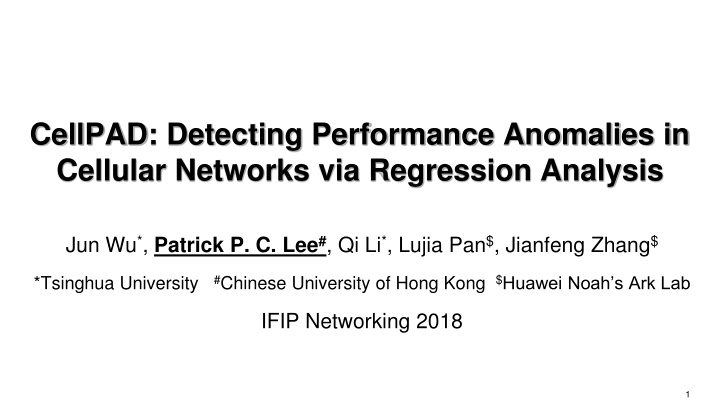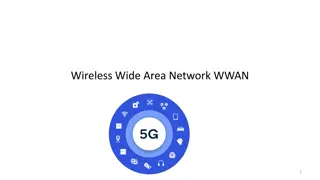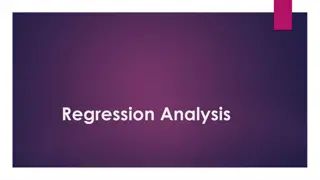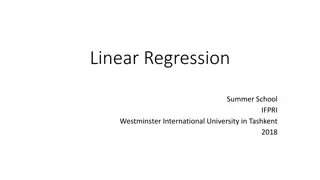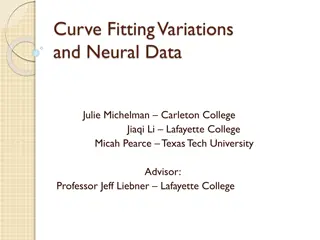Detecting Performance Anomalies in Cellular Networks via Regression Analysis
The study focuses on detecting performance anomalies in cellular networks using regression analysis. It addresses challenges such as labeling, rare anomalies, and correlated factors. The tool CellPAD is introduced for anomaly detection, supporting various prediction algorithms and offering insights from a large-scale KPI dataset analysis. The dataset covers a 17-week period and includes 12,463 cells with 6 KPIs. Seasonality, trends, and positive correlations among KPIs are also analyzed to enhance anomaly detection.
Download Presentation

Please find below an Image/Link to download the presentation.
The content on the website is provided AS IS for your information and personal use only. It may not be sold, licensed, or shared on other websites without obtaining consent from the author.If you encounter any issues during the download, it is possible that the publisher has removed the file from their server.
You are allowed to download the files provided on this website for personal or commercial use, subject to the condition that they are used lawfully. All files are the property of their respective owners.
The content on the website is provided AS IS for your information and personal use only. It may not be sold, licensed, or shared on other websites without obtaining consent from the author.
E N D
Presentation Transcript
CellPAD: Detecting Performance Anomalies in Cellular Networks via Regression Analysis Jun Wu*, Patrick P. C. Lee#, Qi Li*, Lujia Pan$, Jianfeng Zhang$ *Tsinghua University #Chinese University of Hong Kong $Huawei Noah s Ark Lab IFIP Networking 2018 1
Motivation Performance anomalies can disrupt cellular networks e.g., outages, malfunctions, disconnections, performance drops, etc. Key Performance Indicators (KPIs) Time-series measurements for network elements and resource usage KPI anomalies: e.g., unexpected patterns at specific time instants or over a period of time Goal: Detecting KPI anomalies Maintain network dependability Improve subscribers quality-of-experience 2
Challenges Anomaly detection is challenging: No best algorithms for all problems Labeling (i.e., identifying ground truths) is labor-intensive Differentiating normal and abnormal points is hard Anomalies are rare Specific challenges in cellular networks that must be addressed: Internet traffic exhibits both periodic and trend patterns Factors may be correlated e.g., Data transmission and radio resource usage 3
Our Contributions Trace-driven analysis on a large-scale KPI dataset from a metropolitan LTE network in China CellPAD, a KPI anomaly detection tool Detect drop and correlation anomalies Support various prediction algorithms (incl. statistical and ML regression) Account for seasonality and trends Provide a feedback loop for model retraining Insights from evaluation of CellPAD on the KPI dataset Source code: http://adslab.cse.cuhk.edu.hk/software/cellpad 4
Dataset Long-duration: 17 weeks, hourly basis November 7, 2016 to January 8, 2017 February 13, 2017 to March 12, 2017 April 10, 2017 to May 7, 2017 Large-scale: 12,463 cells with 6 KPIs User population (USER) Radio resources (RRC, ERAB, and PRB) Data transmission load (THR and DUR) LTE network 5
Seasonality and Trend Seasonality Trend Seasonality: stable diurnal pattern Trends: high trend variation pattern in some cells Trend variation captures the change of the averages of sliding windows 6
Correlation KPIs are positively correlated 7
Variations High variances of KPI values and KPI correlations in some cells Indicators of anomalies 8
Anomalies Sudden drops: sudden performance degradation of KPI e.g., a sudden drop in number of users disconnections of many users Correlation changes: sudden deviations of two correlated KPIs e.g., more RRC request attempts but same number of users cell failure Assumptions: Per-cell anomaly detection Root causes unknown 9
CellPAD Architecture Anomaly Detection Feature Engineering KPI Streams Predictors Retrain Sudden Drop Y N Normal Instances Anomaly? Correlation Change Input: stream of KPI instances Output: normal instances or anomaly instances 10
Predictors Each predictor returns a predicted value for each hour based on the underlying prediction algorithm Prediction algorithms: Simple statistical modeling Exponentially weighted moving average (EWMA); Weighted moving average (WMA); Holt-Winters (HW); Local correlation score (LCS) Linear regression Simple linear regression (SLR); Huber regression (HR) Tree-based regression Regression tree (RT); Random forest (RF) 11
Feature Engineering Features Sudden drops: one predictor for a KPI indexical features: hour (0-23) and day (0-6) indexes numerical features: numerical operations <win, oper> Correlation changes: two predictors for KPIs Predictor of one KPI takes the value of another KPI as feature Hour and day indexes for tree-based models Trend removal Compute the average over a sliding window of 168 hours Divide the raw value by the computed average 12
Anomaly Detection Sudden drops ???? ???? ???? Drop ratio: ? = Correlation changes ???1? ???1? ???1? ???2? ???2? ???2? Change ratio: ?1= , ?2 = N-sigma rule Sudden drop if ? < ? ? ? Correlation change if ?1 2< ? ? ? or ?1 2> ? + ? ? 13
Evaluation Goal: evaluate accuracy of CellPAD on the KPI dataset How to label anomalies? Synthetic anomalies: Select a fraction of KPI instances and change their values by 30-100% Rule-based anomalies: Identify the KPI instances whose raw values have obvious deviations Results: 3-4% anomalies in total Bootstrap the models with first two weeks of KPI instances Randomly select 80 cells for our evaluation 14
Sudden Drop Detection Simple statistical modeling Random forest Trend removal is critical for improving accuracy Random forest with trend removal is most accurate Simple statistical modeling (e.g., EWMA, WMA) can also be accurate 15
Correlation Change Detection Trend removal doesn t necessarily improve accuracy Correlated KPIs with different trends imply correlation change Huber detection without trend removal is most accurate 16
Comparisons with Twitters Detector CellPAD (using random forest) achieves higher accuracy Twitter s detector builds on statistical modeling 17
Effects of Model Retraining Effects of feeding back normal instances for model retraining: Sudden drop: similar Correlation change: improved No significant differences for different thresholds 18
Conclusions Trace-driven analysis Design of CellPAD Detect sudden drops and correlation changes Support various statistical and ML-based regression algorithms Address seasonality and trends in anomaly detection Provide a feedback loop for prediction model retraining Trace-driven evaluation on accuracy of CellPAD No single prediction algorithm is an absolute winner in both sudden drop and correlation change detection 19
